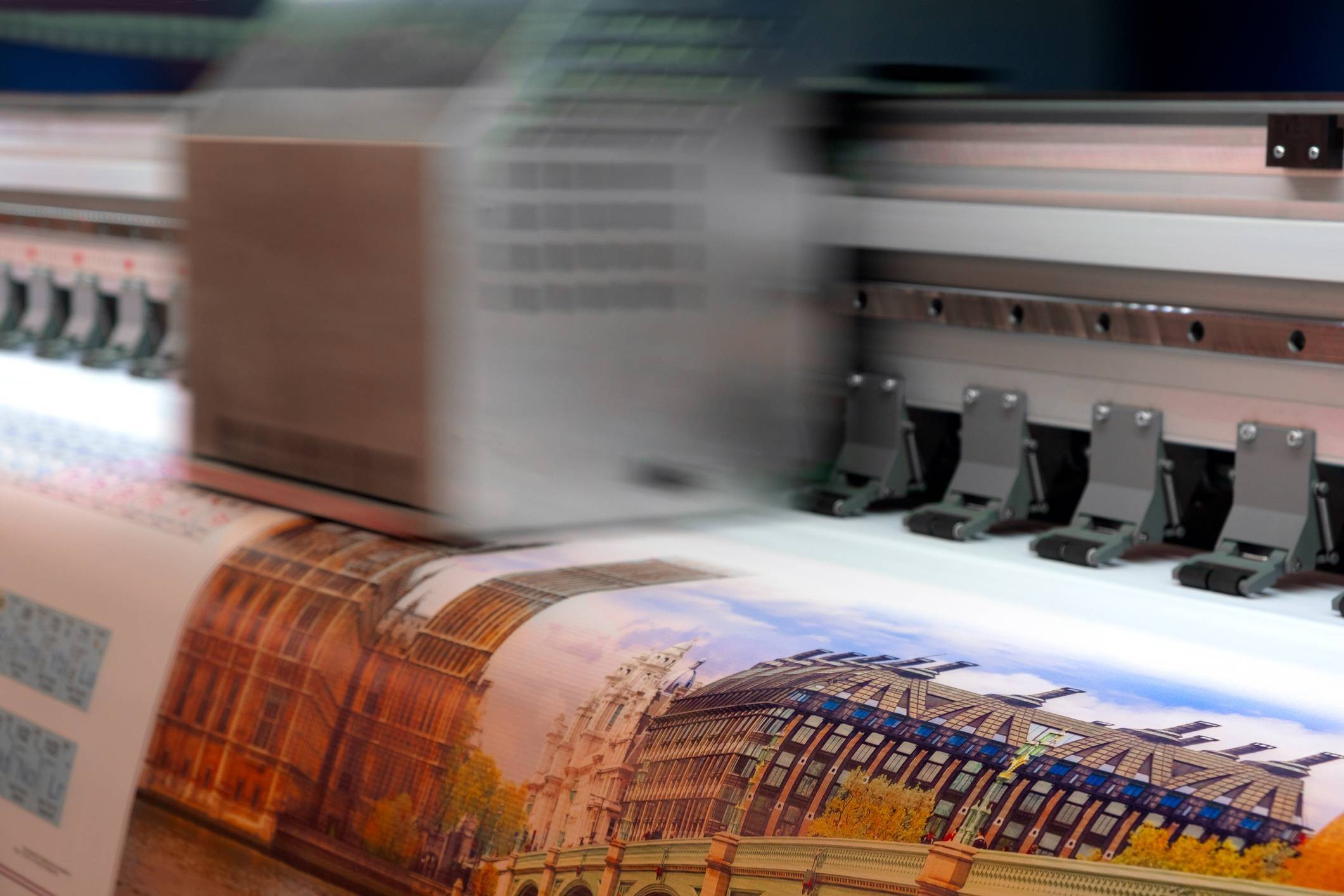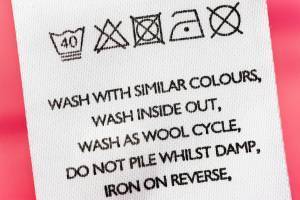
Kao Collins Fade Resistant Inkjet Inks
Download
Digital textile printing is a printing method for textiles and garments that uses industrial inkjet technology to print colorants onto fabric. As an alternative option to traditional screen-printing, printing textiles and garments with industrial inkjet systems offers many advantages for single pieces, mid- to small-run cycle production, and long-runs.
How the Direct-to-Textile Printing Process Works
Printing onto textile fabrics using industrial inkjet systems typically involves these steps:
See Our Textile Inks
Get Started
- The first step in digital textile printing is generally pretreating the fabric with liquid solutions that prepare it to accept the dye and better absorb the color.
- Next, the fabric is fed through the inkjet printer, which sprays the ink onto the textile with tiny droplets.
- The final step in most cases is “fixing” the fabric, which ensures the permanency of the printed design. Depending on the type of textile and type of ink, fixing may involve steam, dry heat, or pressure, or a combination of these.
DTG and DTF Printing
Although both terms are used to describe printing on textiles, “DTG” printing and “DTF” are slightly different in meaning. Direct to Garment (DTG) printing involves printing on textiles and garments using specialized or modified inkjet technology. Direct to Fabric (DTF) printing involves spraying ink directly on a roll of fabric.
Depending on the type of fabric, various inks can be used for DTG and DTF printing, including:
- Pigment ink is used for cotton fabrics
- Acid dyes work primarily with nylon and silks
- Reactive dyes provide the best results on cotton and other viscose materials
- Disperse dyes (sublimation) are almost exclusively used with polyester
Common Raw Materials for Textile Printing
The materials that are most commonly used in textile production and textile printing include:
 Natural fibers (cotton, linen, rayon, etc.)
Natural fibers (cotton, linen, rayon, etc.)- Polyesters
- Nylon
- Animal fibers – (silk, wool, cashmere, etc.)
- Blends – (polyester+cotton, nylon+wool, etc.)
Textile Printing Applications
While most of us read “textile printing” and think mainly of clothing, there are many different applications for industrial inkjet printing when it comes to textiles:
- Clothing
- Upholstery
- Furniture
- Napkins
- Rugs
- Gifts & Accessories
- Bags
Evolving Expectations for Textile Inkjet Printing
Find the best inkjet printing inks to match your textile substrate.
ExploreSame Process, Better Results
The process of inkjet printing directly onto garments remains essentially the same as ever: Using an inkjet printer to print images digitally, the image is placed on fabrics only in this case. The result is finished textiles and garments with the same impressive detail and color variation that one might expect from the home or office printers they use every day.
New Capabilities for New Fabrics and Blends
Once capable of only being used on cotton or cotton blend-based garments, DTG is now expanding to polyester and other fabrics. Inkjet printing on textiles has been made possible by improvements to the technology over the past decade, resulting in higher resolutions and speeds.
One of the most significant and disruptive impacts of digital inkjet technology for DTG printing was the ability to produce designs in small batches efficiently. This remains a huge advantage for the DTG process today. If the application requires a significant number of one-off or drop-shipped products, DTG is by far the most cost-effective printing method available. As inkjet technology improves, this gap between traditional printing and direct-to-garment printing continues to widen.
In addition to cost-effective small batches, direct to garment printing requires a minimal upfront investment, especially when compared to screen printing.
In terms of the actual finished products, DTG offers easy customization, extensive color options, and maximum detail in designs. The images come out looking as crisp and accurate as possible, and full-color printing happens to be extremely affordable as well. With printer inks that attach directly to fibers, the result becomes an impressive hand that feels like it is part of the fabric, often a cherished trait among consumers.
How Digital Textile Printing Delivers Increasing Value
 The move to digital printing of textiles also offers the opportunity for fashion designers to be closer to their customers. With short fashion cycles, production doesn’t need to be located across the globe. This also opens the door for premium pricing. Unique designs demand higher prices because of scarcity. Now high-end brands like Dolce & Gabbana and Hermes depend on inkjet textile printing to test new designs on customers by delivering products to market faster.
The move to digital printing of textiles also offers the opportunity for fashion designers to be closer to their customers. With short fashion cycles, production doesn’t need to be located across the globe. This also opens the door for premium pricing. Unique designs demand higher prices because of scarcity. Now high-end brands like Dolce & Gabbana and Hermes depend on inkjet textile printing to test new designs on customers by delivering products to market faster.
New & Emerging Fabric Printing Technologies
- Inkjet equipment/technology used to print on textile materials, including direct-to-garment printing, is constantly being upgraded with new features and efficiencies that increase the ROI and appeal to textile producers.
Sustainability Advantages
- Using industrial inkjet printers reduces water consumption during the DTF printing process.
- Less water and/or heat is needed for pre-treatment and post-treatment curing of the inks.
Faster Adaptability for Brands and Clothing Lines
- Changing fashion trends are not a problem because digital printers can quickly and easily change printed designs, colors, and other parameters.
- Customized designs are easier to test, iterate, and print when using industrial inkjet systems.
Reduced Costs
- The higher the demand, the more economical it is to inkjet print the necessary supply.
- The more materials that are printed, the cheaper the cost per unit.
Supports Growing eCommerce Clothing Sales
- With the rapid increase in online shopping, digital printing allows for more versatility.
- In the post-covid world, digital textile printing will become the new normal as shopping continues to shift online.
Creating Demand and Scarcity in High Fashion
- Unique designs have higher demand, and inkjet printing makes it easier to print them.
- Garments and fabric can be priced higher for limited runs because of scarcity.
The Best Inkjet Inks for Textile Printing
Contact our Experts
Contact
In textile printing, the challenge for ink manufacturers is creating the right binder that works on all fabrics. For some textiles, the material is pretreated with a primer, which aids in binding the ink to the fabric. Designers now have options for using ultraviolet fluorescent inks that display secondary designs when exposed to certain light wavelengths. This opens up new options for creativity.
Choosing the Right Ink for DTG
Receive product updates and insights
Subscribe
Choosing the right ink for printing a certain garment involves knowing the fabric. Many acid-dye inkjet inks work on nylon, lycra, and silk. These inks resist fading from water and chlorine and are often used for swimwear. Cotton and wool, on the other hand, need reactive inkjet inks. This ink chemically reacts with the natural fibers. Dye-sublimation inkjet inks are used with transfer papers that are used for polyester materials.
Pigmented inks are the holy grail of ink formulations. They are universal and can generally be used on any textile material, thus eliminating the need for switching inks for different products. Think of pigmented ink like the snowflakes in the liquid of a snow globe, only on a microscopic level. However, the pigments in ink remain suspended, unlike the flecks in the snow globe that settle.
As industrial printhead technology continues to expand, our textile inks are advancing DTG (direct-to-garment) and DTF (direct-to-fabric) printing by offering low-inventory, demand printing in the fast-fashion industry reduced time-to-market, no upfront engraving costs, low labor costs, and more.
Types of Textile Printing Inks
Disperse Inks or Sublimation inks
The sublimation inks are infused onto synthetic fabrics with the application of heat. The highest quality piezo sublimation inks require less energy for setting the inks into heat-sensitive synthetic materials to avoid compromising the textile material. Fibra textile inkjet inks from Kao Collins are commonly used for printing common synthetic fabrics.
Features
Known for their optimum effectiveness, compositional accuracy, and enhanced shelf life, sublimation inks from Kao Collins are processed to offer the following features:
- Color sharpness, high resolution, lifelike image upon transfer
- High transfer rate
- Good scratch resistance and laundry resistance
- Suitable for piezo-electronic printers
- Suitable for Ricoh and under development for other inkjet technologies
Applications
 While sublimation inks have various garment and textile printing applications, they are more commonly used for the following:
While sublimation inks have various garment and textile printing applications, they are more commonly used for the following:
- Transfer Printing on Polyester
- Apparel Printing
- Flag Printing
- Indoor Display / Advertising Transfer Printing
- Sports-wear Printing
- Home and Office Decor Printing
- Personalized article Printing
- All Types of Dye Sublimation Transfer
Acid Dye Inks
Acid dye inks produce vivid and brilliant colors on animal fibers, including wool, leather, silk, and synthetic protein fibers such as nylon, by utilizing their acidic properties. Acid dye’s unique characteristics allow printed inks to penetrate the material.
Features
Acid dye inks deliver delicate printing resembling that of a traditional printing process, and offer the following advantages:
- Vibrant colors
- Novel and unique image designs are printable
- Ability to print on animal fibers
- Ability to print on synthetic protein fibers
Applications
Acid dye inks can be used in a variety of textile printing applications, including:
- Clothing accessories
- Banners and flags
- Upholstery
- Swimwear
- Watchbands
Pigment Inks
Pigment textile pigment inks contain a binder and a binding agent, which fix the color to the fibers on heating, and print fabrics with vibrant colors without losing their breathability and water absorbability. A wide range of materials is available for print applications, including apparel, such as T-shirts, signage, flags, and polyester. Furthermore, the ink has a low formaldehyde content and has minimal impact on human skin and the natural environment.
Features
Pigment inks have the following features
- Vibrant Colors
- Resistance to bronzing
- Minimal impact on human skin and natural environment
Applications

The most common printing applications of pigment ink involve apparel, but also include:
- T-shirts
- Signage
- Flag Printing
Reactive Inks
Reactive dye ink enables printing on cotton, hemp, silk, rayon, and some kinds of polyester. These dye inks produce vibrant colors, reproduce a wide gamut of colors, and have water resistance, light-fastness, and rub-fastness because of dyestuff molecule bonding with the fibers.
Features
Reactive inks offer the following advantages
- High color reproducibility
- Light-fastness
- Rub-fastness
- Water resistance
Applications
 Common applications of reactive inks include:
Common applications of reactive inks include:
- Home textiles
- Curtains
- Draperies
- Rugs
Latex and LED inks
Kao has developed latex and LED inks without losing the vibrant color and high color reproducibility of solvent inks. Resins in the latex ink are dissolved by heat and form a membrane to fix pigments to the media’s surface firmly. The latex ink allows for printing on a wide range of materials, including PVC, paper, fabric, and PET film, without the ink absorbing layer, which is typically difficult to print on with solvent ink. Eco-conscious low Volatile Organic Compounds (VOC) formulation latex ink does not require special ventilation in the workplace; therefore, it reduces any adverse operator health effects.
Features
Latex and LED inks offer the following benefits
- Eco-Friendly Inks
- Less Odor
Applications
Common applications of Latex and LED inks are
- Fence fabric
- Awnings
- Flags
- Banners
What is the outlook for inkjet inks for textiles?
As the demand for inkjet-printed textiles continues to grow, so will the capabilities of industrial inkjet printing technologies. Manufacturers need high-quality textile inks that print on an array of fabrics to meet the performance requirements and evolving expectations of fashion designers and consumers. Clothing and textile manufacturers need to choose an ink provider who is always thinking about the future and customizing textile inks for specific fabrics.
Contact Kao Collins about inkjet inks for direct-to-fabric printing.
Download Our Guides to Inks for Improving Performance
- Kao Collins Eco-friendly Inkjet Inks Support Sustainability
- Kao Collins Inkjet Inks with Wide Color Gamut






